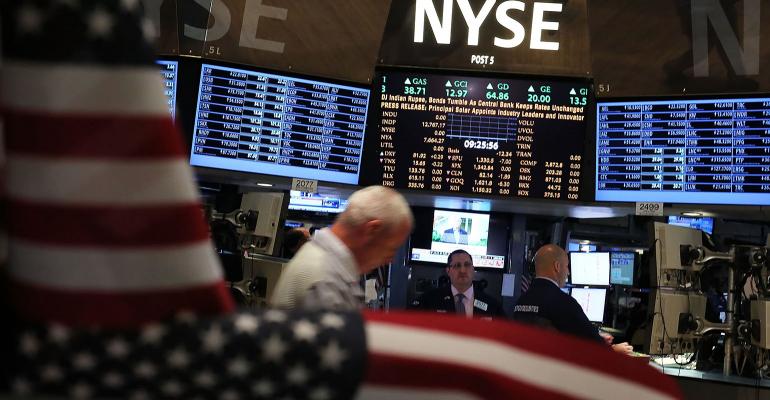(Bloomberg) -- Getting John Beatson to pick stocks for you used to require a cool $25 million or thereabouts. Thanks to the newest trend in money management, these days it’s more like $25.
That’s roughly the price of a share in the Bushido Capital US Equity ETF (ticker SMRI), an actively managed equity vehicle launched by Beatson’s firm Sepio Capital LP last month. It means pretty much anyone can tap him for his stock-picking skills, and even those who don’t invest can see every trade he makes in the ETF given its transparent design.
Sepio is among a small but growing group of elite Wall Street players who are slowly joining the march into exchange-traded funds. Along the way, they’re opening up access to strategies and expertise that for years were the sole preserve of big institutions, family offices and the like — all for a shot at the booming $7.2 trillion arena.
Yet going mass-market is not the primary goal, according to Beatson. The Sepio ETF has launched with around $200 million of existing assets converted from its separately managed accounts, a type of a private investment product commonly used by the wealthy to hold securities directly.
“First and foremost, we want to do this to benefit our current clients,” said the co-chief investment officer. “It’s on average pretty clear, at least with respect to US equities, what the most advantageous structure is for taxable dollars.”
The aim is to exploit the famous tax efficiency of the ETF wrapper, which means funds rarely incur capital gains tax, instead transferring the burden to investors when they exit. That keeps more cash invested for longer, helping funds to earn more.
Read more: ETF Tax Dodge Is ‘Dirty Little Secret’ to Escape Capital Gains
About $75 billion now sit in ETFs converted from mutual funds, Bloomberg Intelligence data show, following the first ever switch in 2021. They’re mostly chasing that tax advantage, or tapping rampant investor demand for ETFs, which have absorbed hundreds of billions every year as stock mutual funds lose similar amounts.
But the conversion of SMAs like Beatson’s is a newer phenomenon.
ETF Architect, the specialist “white label” firm that helped Sepio through the issuance process, has listed two other ETFs that were converted from SMAs and has around nine similar deals on the way, adviser Wes Gray says. Exchange Traded Concepts, a rival, has “a couple” of SMA conversions coming in the first quarter of 2024, according to Chief Executive Officer Garrett Stevens.
“The wrapper of the future for many in the commingled space will be the ETF,” said Lisa Mantil, global head of the Goldman Sachs ETF Accelerator. “You need to position your strategies and your core strengths as an investment manager and deliver it in the wrapper in which your clients want it.”
Mantil has been surprised by the mix of clients she’s spoken to since leading the creation of Goldman Sachs Group Inc.’s ETF platform late last year. While about 60% are asset managers, the balance comprises hedge funds, financial advisers, insurers and family offices, she said. Goldman has consulted on several debuts so far, including from Grantham Mayo Van Otterloo and Brandes Investment Partners.
Hedge fund switches are rare, even compared with SMA conversions.
Illiquid assets, complex strategies and concentrated portfolios — all of which are common features in hedge funds — can be challenging to fit into an ETF structure, which tend to have high liquidity, full transparency and low fees. The first hedge fund-to-ETF conversion liquidated earlier in 2023 after less than three years in business.
Still, several hedge funds have launched ETFs to run alongside existing strategies, while at least one other firm has completed a conversion.
When Euclidean Technologies flipped its hedge fund into the Euclidean Fundamental Value ETF (ECML) in May, it dropped its management fee from 1.5% to 0.95% and removed a 15% performance fee. Founder and former tech entrepreneur John Alberg, who has much of his own net worth in the machine-learning fund, had a clear incentive to make the leap anyway.
“The original driver was the tax efficiency and the benefit that gives to myself and my very loyal investors,” he said. “Is there going be a lot of resistance on the part of hedge fund managers because of the implications for fees? It could be in the end they just don’t really have any choice and they’re pushed in this direction because they want to keep investors that demand it.”
Converting another type of fund into an ETF doesn’t come cheap — Stevens at ETC estimates the cost to be about $125,000 for one conversion — but the tax advantage can add up. According to one academic study, it has enabled ETFs to beat active mutual funds by 0.92% on average annually in recent years.
While SMAs have the benefit of being able to sell losing positions for the purpose of offsetting capital gains incurred by a particular investor, they can quickly run out of losses to harvest. In an ETF, assets that have gained can be effectively swapped out of the fund during the creation-redemption process without a taxable event taking place. In some cases, artificial flows in and out of an ETF are even created for that very purpose.
Ultimately that’s what convinced Sepio’s Beatson: If he was good enough, all his stock picks would be up, and he didn’t want gains taxes to be a problem.
The tax advantage has fostered a growing industry of financial advisers that only put client money in ETFs, says Ward Brown, director of portfolio engagement at Argent Capital Management. Argent converted SMAs into the Argent Mid Cap ETF (AMID) last year and is mulling doing the same for more of its strategies.
“There’s a number of firms and structures and outlets where the entire model of an investment is built exclusively with ETFs,” he said. “If you are without that, the conversation doesn’t even get off the ground.”




